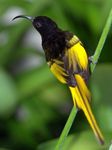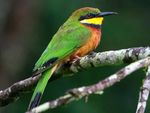ABA Kenya Mount Kenya & Rift Valley Lakes Extension - Rockjumper Birding Tours
←
→
Page content transcription
If your browser does not render page correctly, please read the page content below
ABA Kenya
Mount Kenya & Rift Valley Lakes Extension
16th to 21st February 2022 (6 days)
Jackson's Francolin by Keith Valentine
Two of the country’s most iconic rift valley lakes, Mount Kenya and the scenically spectacular Aberderes
National Park all in just 6 days is what this incredible extension offers. One of the undoubted highlights
will be birding the forested slopes of Mount Kenya where specials are numerous and include the likes ofRBL ABA Kenya Mount Kenya & Rift Valley Lakes Extension Tour Itinerary 2
Eastern Bronze-naped Pigeon, Hartlaub’s Turaco, Abyssinian Ground Thrush, Bar-tailed Trogon,
Golden-winged Sunbird, Kandt’s Waxbill and Abyssinian Crimsonwing. We will also target several
Kenyan endemics including the striking Jackson’s Francolin, highly endangered Sharpe’s Longclaw,
localized Hinde’s Babbler and Aberdere Cisticola. The Rift Valley lakes offer high volumes of birds and
we can expect many days of 100+ species with specials including Jackson’s and Hemprich’s Hornbills,
Northern Masked Weaver, Bristle-crowned and Magpie Starlings and Gambaga Flycatcher.
THE TOUR AT A GLANCE…
THE ITINERARY
Day 1 Nairobi to Lake Naivasha via Kinangop Plateau
Day 2 Lake Naivasha to Mount Kenya via Aberderes National Park
Day 3 Mount Kenya
Day 4 Mount Kenya to Lake Baringo
Day 5 Lake Baringo
Day 6 Lake Baringo to Nairobi and depart
TOUR MAP:RBL ABA Kenya Mount Kenya & Rift Valley Lakes Extension Tour Itinerary 3
THE TOUR IN DETAIL…
Day 1: Nairobi to Lake Naivasha via Kinangop Plateau.
This morning we leave Nairobi behind us, after breakfast, as
we depart for Lake Naivasha. En route we will pass through
Kieni Forest and the Kinangop grasslands. Kieni Forest
holds a number of special birds and we hope to see
Hartlaub’s Turaco, Mountain Oriole, Placid Greenbul,
Black-fronted Bushshrike, Black-throated, Chestnut-
throated and Black-collared Apalis, Waller’s and the scarce
Abbott’s Starling and the endemic Kikuyu White-eye. The
Kinangop Plateau is an area of natural upland grasslands
which are threatened by encroaching cultivation. Here the
main prize is the rare, endemic Sharpe's Longclaw. Sadly,
this species continues to lose habitat at an alarming rate
however our knowledge of the species exact requirements
means that our chance of success is very high. More
widespread species include Augur Buzzard, the magnificent
Grey Crowned Crane, African Snipe, Black-winged
Lapwing, African Stonechat, Levaillant’s Cisticola, Golden-
winged Sunbird and Long-tailed Widowbird.
Hartlaub’s Turaco by Markus Lilje
Arriving at Lake Naivasha in the late afternoon we will drive
around the edge of the lake and through the woodlands. Birds that may be seen here include Southern
Pochard, Black and Goliath Herons, Saddle-billed Stork, Three-banded Plover, Long-toed Lapwing,
White-fronted Bee-eater, Northern Pied, Arrow-marked and Black-lored Babblers, White-headed Barbet,
Brown-backed Honeybird, Anteater Chat, Banded Martin, Grey-rumped Swallow, the lovely Grey-
capped Warbler, White-winged Widowbird and Brimstone
Canary.
Day 2: Lake Naivasha to Mt Kenya via Aberdares
National Park. This morning we will enjoy an early
morning bird walk around our hotel grounds where
wonderful species such as White-bellied Tit, Nubian
Woodpecker, Green Wood Hoopoe and Yellow-collared and
Fischer’s Lovebirds maybe be seen. Next, we will embark on
a boat ride on Lake Naivasha before making our way to the
stunning Aberdares National Park. This park protects pristine
montane grasslands and forests. Whilst exploring this scenic
area we may see Mountain Buzzard, Rufous-breasted
Sparrowhawk, African Yellow Warbler, Bronzy, Malachite,
Eastern Double-collared and spectacular Golden-winged
Sunbirds, Moorland Chat and two highlight endemics:
Aberdare Cisticola and Jackson’s Francolin. Forest patches
harbour Moustached Tinkerbird, Doherty’s Bushshrike,
Kikuyu White-eye and Slender-billed and Waller’s Starlings.
We then continue to our accommodations at Mount Kenya. Golden-winged Sunbird by Markus LiljeRBL ABA Kenya Mount Kenya & Rift Valley Lakes Extension Tour Itinerary 4
The lodge grounds here are excellent for
mammals and offer opportunities for Suni,
Giant Forest Hog, African Buffalo and four
species of mongoose.
Day 3: Mount Kenya. Today we will have a
full day to bird the slopes of Mount Kenya, as
we ascend to the Meteorological Station. If the
weather is clear, we shall awaken to views of
the snow-capped summit of Mount Kenya
(5199m). Birds that we will be targeting in this
area include Black Sparrowhawk, the
magnificent Crowned Eagle, further
opportunities for the endemic Jackson’s
Francolin, African Olive and Eastern Bronze-
Cinnamon-chested Bee-eater by Cuan Rush naped Pigeons, Red-fronted Parrot, Scarce
Swift, Crowned and Silvery-cheeked
Hornbills, beautiful Bar-tailed Trogon, White-headed Wood Hoopoe, Moustached and Yellow-rumped
Tinkerbirds, Abyssinian Ground Thrush, Black Saw-wing, Yellow-whiskered, Slender-billed and Olive-
breasted Greenbuls, White-starred Robin, Cinnamon Bracken Warbler, Mountain Yellow Warbler,
Chestnut-throated, Grey and Black-throated Apalises, White-browed Crombec, White-bellied Tit, Grey
Cuckooshrike, Waller's Starling, Brown-capped Weaver, Yellow-bellied and Kandt’s Waxbills, the
secretive Abyssinian Crimsonwing, Thick-billed Seedeater, Yellow-crowned Canary and, if we are
lucky, Oriole Finch. Mammals we may see include the beautiful Sykes’ Monkey and Guereza Colobus.
At night we should hear the eerie screams of Eastern Tree Hyrax.
Day 4: Mount Kenya to Lake Baringo. After breakfast, we will enjoy a little early morning birding if
we still need a special or two before we head north towards Lake Baringo. Lake Baringo, set in dry rocky
country. There is a variety of different locations to bird around Lake Baringo and options include the
surrounding lake edge, or perhaps Baringo Cliffs targeting various owl species. The two most special
birds at Lake Baringo both have very small
global distributions with Baringo being the most
easily accessible place on the planet to find
them. These are Jackson’s Hornbill and
Northern Masked Weaver. Recently Gambaga
Flycatcher has been found here as well, a species
that is nowhere common. Other species that we
will be searching for include Verreaux’s and
Greyish Eagle-Owls and Northern White-faced
and African Scops Owls, Slender-tailed
Nightjar, Hemprich’s Hornbill, African Black
and Nyanza Swifts, Mocking Cliff Chat, the
quirky Bristle-crowned Starling, Red-fronted
Apalis, Pale White-eye, Fan-tailed Raven,
Rufous-tailed Rock Thrush, Black-throated and
Spot-flanked Barbets, Pygmy Batis, Mouse- Bristle-crowned Starling by Paul Ellis
coloured Penduline Tit, the aptly namedRBL ABA Kenya Mount Kenya & Rift Valley Lakes Extension Tour Itinerary 5
Beautiful Sunbird, Little, Village and
Golden-backed Weavers, and Yellow-
crowned and Northern Red Bishops.
Day 5: Lake Baringo and Kapedo. Today
we plan to visit the Kapedo area. This region
lies to the north of Lake Baringo and is an
area of semi-desert. Special birds here
include Three-banded Courser, Abyssinian
Ground Hornbill, Crested Lark, Pied and
Isabelline Wheatear, Somali Fiscal, Magpie
Starling, White-billed Buffalo Weaver and
the scarce Somali Sparrow. Kapedo is
unfortunately not always accessible as bad
roads and flooding can hamper conditions
on occasion, should this be the case then
Jackson's Hornbill by Keith Valentine
additional time will be spent birding in the
superb Baringo area. Over 470 bird species have been recorded in the general Baringo area and we can
expect to generate a massive bird list, especially with the help of local lads who have become expert bird
guides and stake out some really special birds.
Day 6: Lake Baringo to Nairobi and depart. Today we make our way back to Nairobi where our tour
will conclude.You can also read

























































